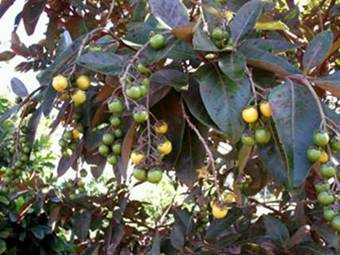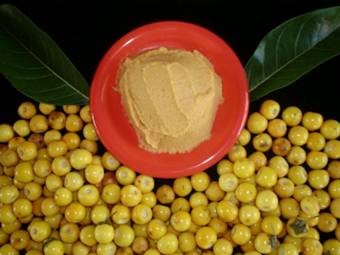BYRSONIMA CRASSIFOLIA, BYRSONIMA INTERMEDIA, BYRSONIMA LANCIFOLIA AND BYRSONIMA STIPULATA
POPULAR NAMES: Murici do Cerrado (B. crassifólia), Murici rasteiro or canjiquinha (B. intermedia), Murici guassú (B. lancifolia) and Murici da Praia (B. stipulata)
MALPIGHIACAEAE
|
Murici do cerrado (B. crassifólia) |
Canjiquinha (B. intermédia) |
|
Murici-guassú (B. lancifolia) |
Murici da praia (B. stipulata) |
INDIGENOUS NAME: Murici comes from the Tupi-Guarani and means "little tree" and the term guassú for the species B. lancifolia means "great result" for other species.
Origin: The various species occur in Brazil: the Murici do Cerrado - in all fields and savannas; Canjoquinha occurs in areas throughout Brazil, the Murici guassú in Amazônia and Murici da Praia in the coastal Atlantic Forest.
Characteristics:
Small tree
Planted in
the site of Frutas Raras:
B.
crassifolia in
January 2002; B.
intermedia
in
September 2002; B.
stipulata in
September 2003; B. lancifolia in September
Tips for cultivation: A fast-growing shrub, prefers red and loamy soils with rapid drainage of rain water and around pH 5.5, is resistant to light frosts to -1°C (30°F) degree. You should plant it in an environment protected from strong winds because their branches break easily!
Propagation:
Seeds are kept in
natural conditions for up to 6 months and germinate in
Planting:
I recommend that they
should be planted in
full sun in a space of 5x5 m (17 x 17 feet) in the case of B.
crassifólia and B.
lancifolia,
space of
6 x 6 m (20 x 20 feet) in the case of B.
stipulata, 2 x 2 m (7
to 7 feet)
in the case of B.
intermedia.
Best planting season
is November to January,
water
Cultivating: The
plant grows fast and needs no special care, it must be hard only for a mentor to
tie the plant not to break, good to remove the shoots that arise at the base
of the stem.
Make pruning training.
Fertilizers containing organic compound, can be (
Uses: The fruit is consumed in-kind, and used in the manufacture of jams, ice cream and other sweets.
Flowering in the site of Frutas Raras: September to February.
Fruiting in the site of Frutas Raras: March to August.
BUY THE BOOK “COLECIONANDO FRUTAS”
Back to the seedlist (English) or back to Malpighiaceae (Portuguese)



